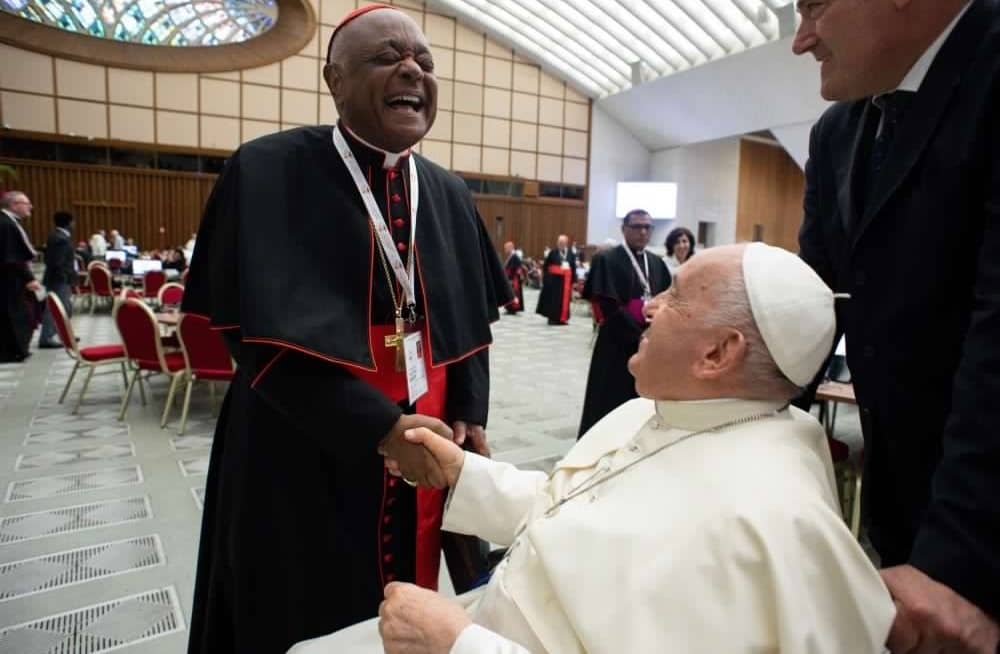[Editor’s Note: British-born Catholic theologian Paul Griffiths taught at Duke University from 2007 to 2018, and is now retired and living in the hills of western North Carolina. He published frequently in Catholic media, especially Commonweal and First Things. His latest book is Christian Flesh, published by Stanford University Press. Recently Charles Camosy discussed the book with Griffiths.]
Camosy: The title of your new book is provocative: Christian Flesh. How is Christian flesh different?
Griffiths: It was mostly because I wanted to think about this that I wrote the book. Scripture and the long Christian tradition has it that baptism does something to us, and one of the ways of talking about what it does is fleshly (or at least bodily): it incorporates us into Jesus so that we are members (limbs) of his body.

That’s very fleshly talk, and it’s supported and deepened by the thought that we eat Jesus’ flesh and drink his blood when we consume the consecrated elements in the Eucharist. So it does seem that Christian flesh is different: it’s participant in – a proper part of – Jesus’ flesh. That, I thought, should have implications for what we do as fleshly beings, and I wanted to think some of those through.
That’s why there are chapters on the most fundamental fleshly activities: eating (taking things into our flesh), dressing (putting things onto our flesh), and caressing (having fleshly exchanges with others). All these need to be understood, and practised, with Jesus in mind, and that makes a difference.
The question is: What kind of difference?
Well, that’s the story of the book: some among our fleshly acts as Christians glorify Jesus; some contradict – speak against – what we in fact are, once baptized, which is participants in Jesus’ flesh. It’s not then, that Christians are a new and different species of human creature; it is that we have, in baptism, entered a new fleshly condition, and that new patterns of fleshly life flow from that.
You devote an entire chapter to clothes. Why? What does how we should think about flesh mean for how we should think about clothes?
Clothes are very important for all of us: they protect us, they badge us as this or that kind of person with this or that local significance, and they ornament us. When we Christians dress ourselves, we dress Jesus, not only in the scriptural sense of putting on Christ – wearing God, we might say – but also in the sense that the person we’re dressing is Jesus.
This way of thinking about clothing is in one sense liberating: we are not, as Christians, bound by slavery to local conventions about clothes, and we are therefore free to sit loose to them. Because we are, in our flesh, most fundamentally Christian and not most fundamentally (for instance) male or female or old or young or rich or poor, we’re not bound by and to local conventions about dressing people as this or that.
Those conventions often prompt violence or contempt when they’re transgressed: if you dress as women do locally when you’re a man, or as young people do locally when you’re old, or … then things probably won’t go well for you. But Christians are liberated from all that: we see such conventions for what they are (local habits) and we can justly assess their depth.
Those who think of other identities, of sex, gender, race, class, or what-have-you, as fundamental or essential to them, will think differently about these matters, and will be more likely to think of clothing-codes as bearing fundamental importance, and of offences against them as punishable. When Christians do this, which too often we do, we make a mistake.
But we can also offend Jesus in our dress, and we do that when our mode of dressing ourselves, or forcing others to dress, produces an idol to be staged and controlled and manipulated for use – as a prostitute, a slave, as machine-gun fodder, and so on. Those sartorial stagings speak against Christian flesh.
Your book, admirably, doesn’t shrink from the tough issues, including sex. Indeed, here some of your arguments seem to push against at least one of what many think of as magisterial teaching – and I couldn’t help but think of the provocative plenary address you gave at CTSA a few years ago on theological disagreement. Could you say something about your views on this matter in general – and about this book’s particular instance?
Some of the conclusions I reach in the book, especially about sex, but also, I think, about clothes, and perhaps in minor ways about eating, do indeed stand in tension with magisterial teachings. This doesn’t trouble me much.
I’ve tried to offer a properly and fully Catholic position on the book’s questions, in full awareness that some of its conclusions (but not, I think, its method) aren’t compatible with some magisterial teaching. I’m a Catholic theologian, and that means I don’t make doctrine (the bishops do). My job is to follow a line of thought through, speculatively, to see where it goes – and then to offer it to the Church as a gift.
The gift may or may not be received. It isn’t my task to worry about that. I accept the teaching authority of the Church, and don’t think that anything I’ve written calls that authority into question. I don’t represent what I write in the book as Catholic doctrine. I offer it in the spirit of a child offering something it’s made to its parents. Perhaps it’ll please them, and perhaps not. But here it is.
Catholic theologians have, in this way, a remarkable freedom; it’s more difficult for our Protestant brothers and sisters, for whom it’s more important to be right than it is for us. We, exactly because we’ve no magisterial authority, can relax into thinking: we can try to work it through and work it out.
Christian flesh is living, but one of the thorniest issues in moral theology and moral philosophy today is how to think about the dead body. Indeed, as the concept of dignity falls out of favor in various circles, it is becoming more difficult to talk about the value of a dead body and why it deserves moral regard. Do your insights about living flesh have implications for how we should think about dead bodies?
Yes. This is difficult. I too don’t much like the idea of dignity; and yet I want to preserve the idea that the corpse – the corpus that was once caro – is important. I don’t discuss this in the book, but I think that one way forward with it is through the idea of relics, and the practices connected with them.
The corpse is a relic, in a generic sense of that word, and we don’t treat relics with contempt, or casually. We deal with them in particular, liturgically marked ways, and we attribute power to them. As we should.
Every Christian corpse should be treated in an analogous way: it’s a Jesus-relic because of its baptism. I think that many of the ways in which we, Catholics and not, now treat corpses fail here. Those ways include, but aren’t limited to, dissection, cremation, and public display for the curious or contemptuous, as in museums or at sites of execution.
I of course see that these things aren’t about to change, that some goods flow from them (all culpae involve some felices), and that, at least in the case of cremation, canon law accommodates them. But still. We don’t do well with this.
You and I share an interest in thinking about the theological status of non-human animals. Do your insights about human flesh have import for non-human flesh?
This is an important topic for me. I don’t discuss it in Christian Flesh, other than in very sidelong ways, but I did in an earlier (2014) book on eschatology, called Decreation.
If we think of human flesh generically, and Christian flesh in particular, as brought into being and sustained by its contacts with other flesh (in the womb, via parental nurture, in friendship, in sex, etc.), then we should include among its fleshly contacts those we have with the flesh of non-human animals – and we all have them, like it or not.
We are what we are, in a fleshly sense, in considerable part by way of our relations to, contacts with, and contrasts with the flesh of non-human animals we’ve domesticated (cattle, sheep, dogs, cats, etc.), and of those that trouble us by their presence or that we admire and fear (wolves, mosquitoes, snakes, etc.).
Non-human animals are, like us, flesh: they are living body. We cannot be the flesh we are without their being the flesh they are. Awareness of this ought to make it impossible for us to treat them, in their flesh, in ways that we might reasonably treat non-living things. We ought not factory-farm them (the horrors here can only be fully appreciated up close), slaughter them on an industrial scale, manipulate their genetic material for our benefit, or, in general, blind ourselves either to the importance, for us, of our fleshly relations with them, or to the ways in which their fleshly existence is itself a mode of glorifying the Lord who made them.
Attending closely to our own fleshliness can help us to see theirs, and that can be transformative.
Crux is dedicated to smart, wired and independent reporting on the Vatican and worldwide Catholic Church. That kind of reporting doesn’t come cheap, and we need your support. You can help Crux by giving a small amount monthly, or with a onetime gift. Please remember, Crux is a for-profit organization, so contributions are not tax-deductible.
















